What is Anastasia’s Mate?
Here’s a general setup for Anastasia’s Mate:
- The defending king is usually on the edge of the board, most often on the h-file.
- The attacking side’s knight controls key squares, usually preventing the king from escaping to the g-file or the 8th rank.
- A rook or a queen delivers the final checkmate along the h-file.
In this 3-minute online game, GM Max Dlugy played white against a 2711 elo Lichess-rated player. GM Dlugy opened with the Accelerated London system.
The Accelerated London System is a variation of the London System, which is a solid and flexible opening for White in chess. The London System typically involves White developing their pieces to natural squares with the moves d4, Nf3, Bf4, e3, c3, and sometimes h3.
The Accelerated London System speeds up this development by immediately playing 2.Bf4. The idea is to rapidly develop the bishop and control the e5 square, preparing to support a strong and flexible pawn structure.
The game continued with the main line 1.d4 Nf6 2.Bf4 d5 3.e3 e6 4.Nd2 Bd6 where the bishops are trying to trade each other.
White retreats his bishop to g3. The idea is if black trades his bishop, the h-file will open up with hxg3, leading to a future kingside attack.

Black replied with c5, challenging the center. GM Dlugy developed his other knight to f3 and the opponent castled kingside.
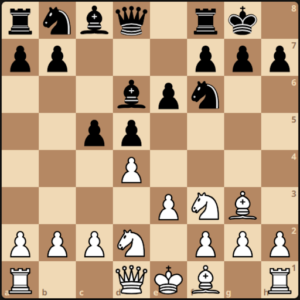
White responded with c3, strengthening the pawn chain. Black replied with Qc7 and white answered with Rc1, challenging the control over the c-file.

The game continued 8…Nbd7 9.c4, white opening the c-file. Black supported his c-pawn with b6, and GM Dlugy pushed his pawn to b4 to continue the attack.
Black spent a bit of time on his reply and decided to play e5, challenging white’s d4 pawn.
GM Dlugy realizes that this is a mistake and proceeds with 11.cxd5.
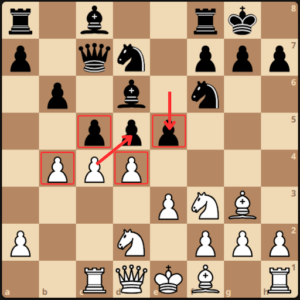
Black answered with 11.exd4 and GM Dlugy recaptured it with Nxd4 (black can’t take it with cxd4 because of Rxc7, losing the queen).
The game followed 12…Bxg3 13.hxg3, trading the dark-squared bishop, and opening the h-file.
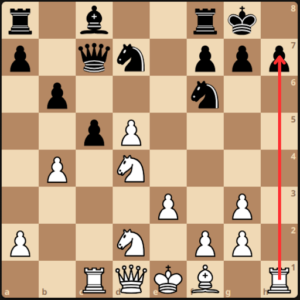
Black repositioned his queen to e5 and GM Dlugy attacked with Nc6. There is no Qxd5 because of the fork on Ne7.
If black plays Qd6, then Nc4 for more action on the board.
Instead, black entered white’s territory with Qb2.
GM Dlugy is planning to trap the queen and pushes his rook to c2.
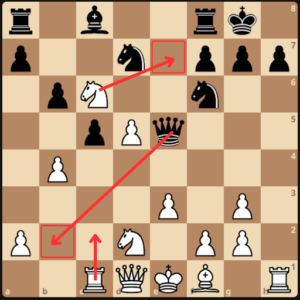
The game followed 15…Qa3 Nc4, driving the Q to a4.
17.Bd3, threatening Anastasia’s mate with Bxh7, Ne7+, Rh7, and Qh5 ideas. In this position, h6 is forced.

The game continued with 17…Re8 Nd6, putting the other knight to suffocate black’s position.
Black brought out his bishop to a6, trying to trade against the light-squared bishop.
GM Max Dlugy refused the exchange and blocked the idea with b5, attacking the bishop.
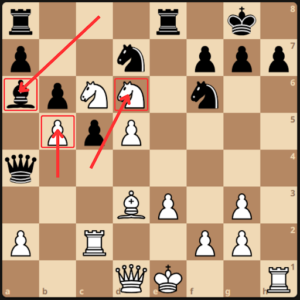
Black ignored the threat and carelessly played 19…Ne5 and GM Dlugy took the free bishop bxa6.
Then black captured the bishop on d3 and white recaptured Qxd3, up a piece.
In this position, black is in trouble. He is down a piece, his queen is misplaced, and there is no real counterplay.
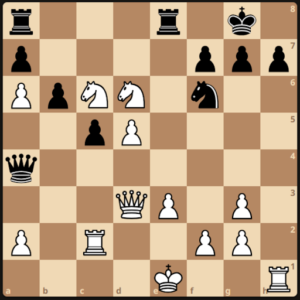
21…Rf8 moving away his rook.
- Rc4, setting up the beautiful Anastasia’s mate.
22…Qxa2
- Ne7+ and white resigned because there’s no solution to stop the mating threat.
After Kh8, the mate follows via Qxh7+ Nxh7, Rxh7+ Kxh7 and Rh4#.
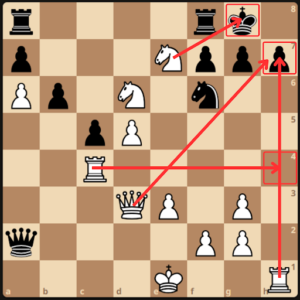
Summary
In chess, controlling the center and proper placement of the queen are fundamental aspects of good play. Mistakes in these areas can lead to significant disadvantages.
Here are some common problems that arose in this game that you should watch out for.
Problem #1: Failing to contest the center allows the opponent to dominate it, providing them with more space and flexibility.
Problem #2: Pushing central pawns too early without sufficient support can make them targets for attack and create weaknesses.
Problem #3: Focusing solely on central pawn moves without developing pieces can lead to a lack of coordination and vulnerability.
Problem #4: Pushing pawns too far without support can create overextended positions that are hard to defend.
Problem #5: Placing the queen where it can be easily attacked or harassed by the opponent’s pieces can lead to loss of material or tempo (black’s Qe5 – Qb2 maneuver are really bad moves).









